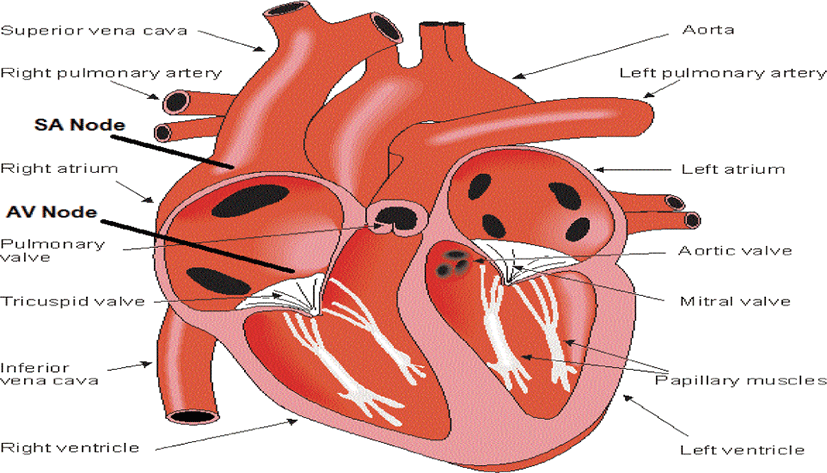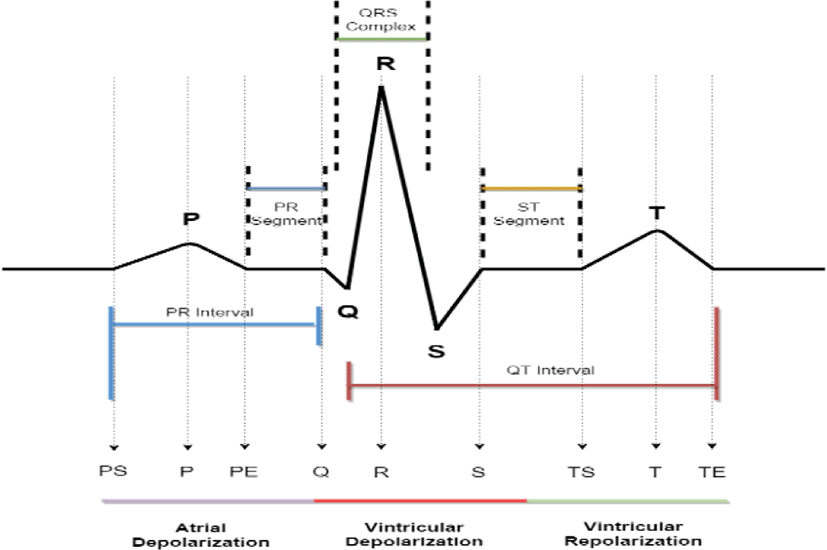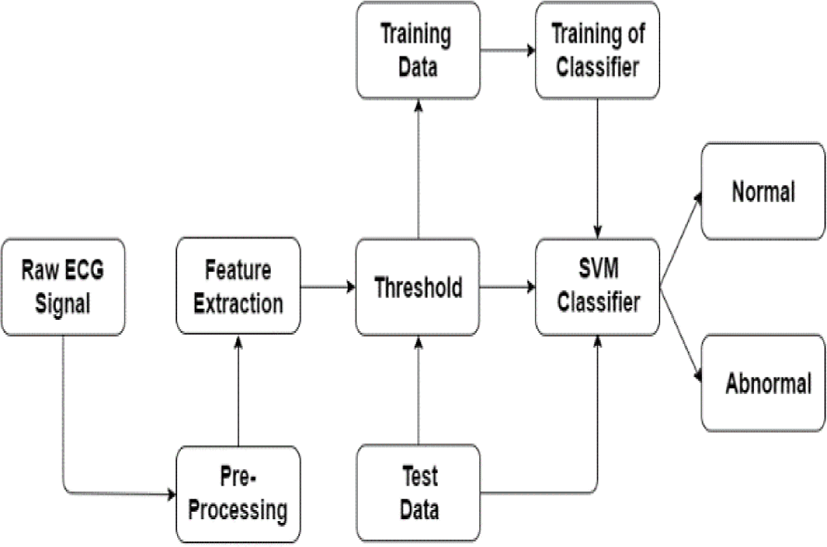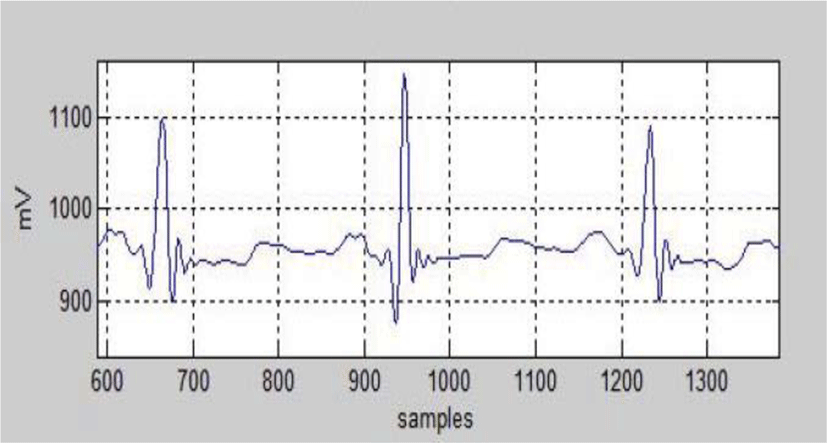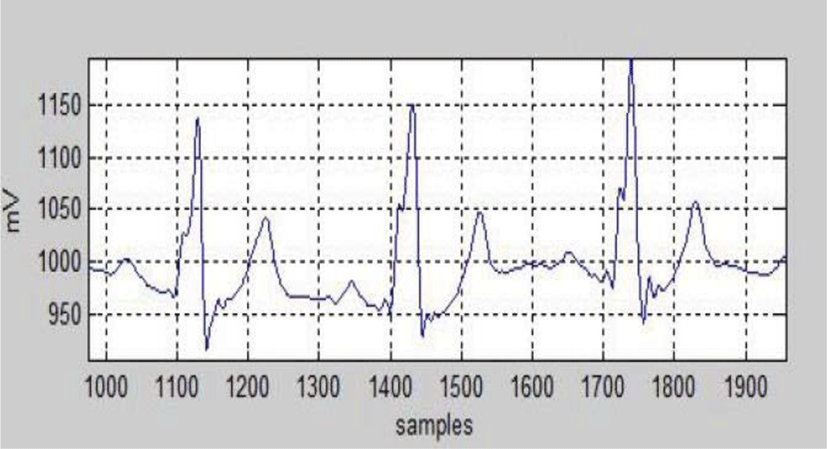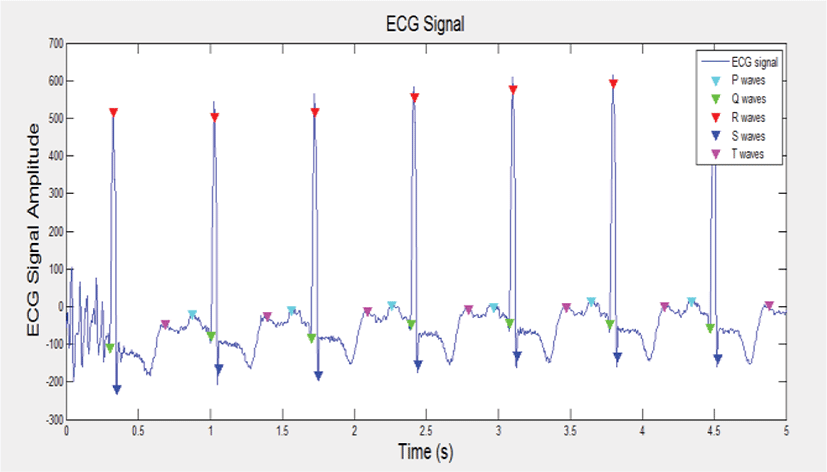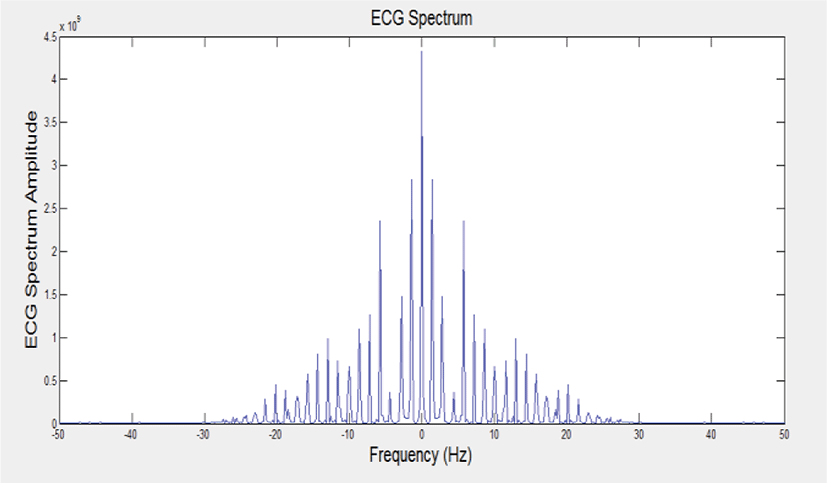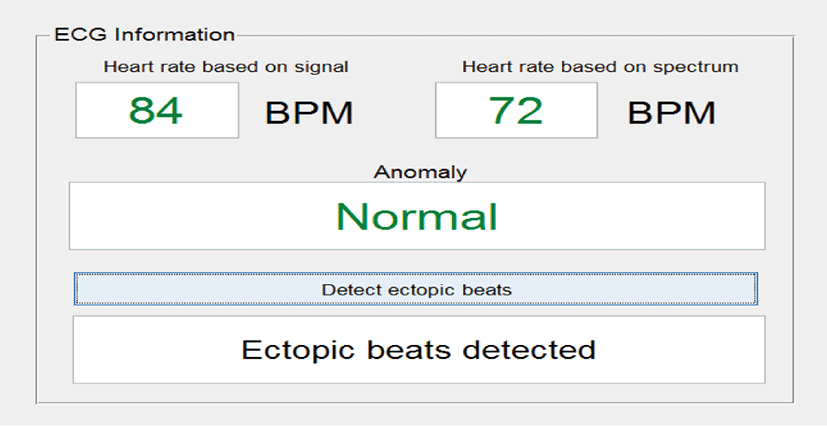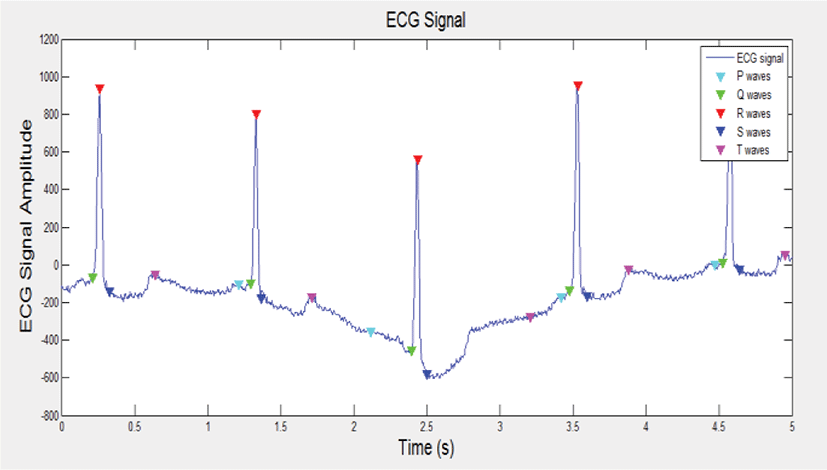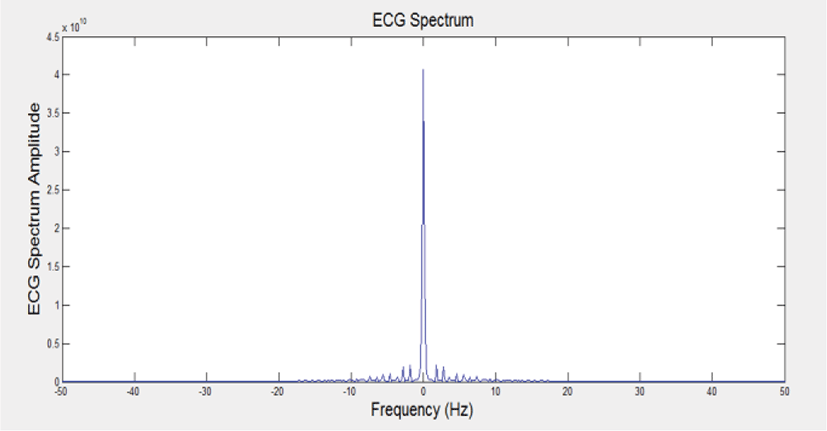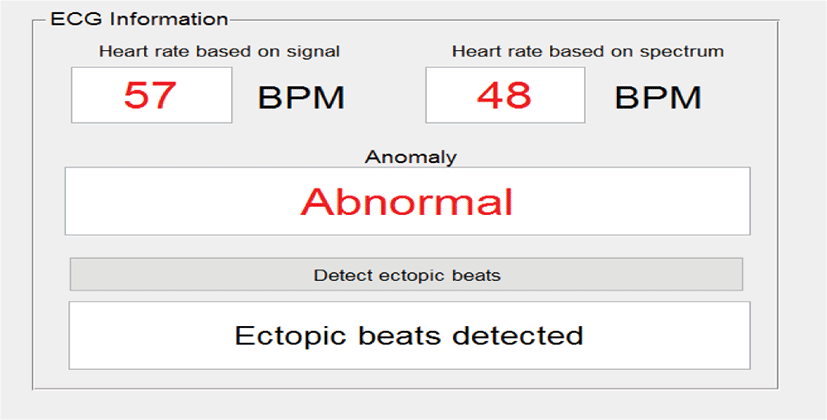I. INTRODUCTION
The current mainstream is highly demanded for a fine wellness status, as the wellbeing of a person measured via the heart, the core part of well-being. The heart status is measured by the produced ECG signal inside it. The heart consists from four main chambers which are simply in a cone muscular pump format spotted in the bore of the chest; exactly located between the lungs and straightway below the sternum [1]. Heart physiology is shown in Fig. 1. Practically, the heart distributes nutrients and oxygen to our tissues; at the same time carrying away carbon dioxide and metabolic waste for excretion through the lungs and the kidneys by pumping the blood in a circulation manner throughout the whole body. The first two chambers located in the upper left and right (called left and right atrium); the third and fourth chambers located in lower left and right are called left and right ventricles. In fact, the senatorial node (SA node), as illustrated in Figure 1 controls the heart contraction rhythm. In addition, it is responsible of triggering the cardiac cycle via the pacemaker by generating electrical pulses and spreading them through the heart conducting through the tissue pathway.
When the signal moves from SA node through the right of depolarization, through which it moves blood into ventricles [2].
During a normal trial of depolarization, the main electrical vector is directed from SA node towards the AV node, and spreads from the right atrium to the left atrium. This turns into the P wave on the ECG. The PR interval is measured from the beginning of P wave to the beginning of the QRS complex. The PR interval reflects the time of the electrical impulse which travels from the sinus node through the AV node and enters the ventricles; it is normally within 120-200ms. Therefore; the PR interval is a good estimation of AV node function. [3, 4].
In our research, we have proposed a method that diagnoses heart abnormality through Discrete Wavelet Transform (DWT), QRS complex detection and support vector machines (SVM) classification. We have reached a high level of diagnosis accuracy comparing with I. A. Karaye et al, J. A. Delgado et al and T. Tinnakornsrisuphap et al methods. The rest of this paper is organized as ECG physiology, related works, contribution and problem stamen, the method, the results and conclusions.
II. ECG PHYSIOLOGY
Briefly, when the heart cells are in rest situation they considered as in polarized case which means that there is no electrical activity is taking place at the moment. Basically, the heart is depolarized when it is in a systole state and repolarized when it is at diastole state. The depolarization case in normal ECG wave takes place from the beginning the P wave until the middle of ST segment as shown in Figure 2, while the repolarization case starts from the T wave [5, 6].
Generally, ECG features categorized as either waveform or characteristic based features. The easiest one to obtain among the features is characteristic based, because starting extraction process just requests ECG fiducial points knowledge about one of ECG complex. Figure 2 PS, P, PE, Q, R, S, TS, T; T represents the correspondence points that intersect with the peaks and boundaries of P, QRS and T waves, named fiducial points. In ideal ECG complex, there are six boundaries and three peaks (P, R, and T) as illustrated in Figure 2 [7].
The main features that aimed to be extracted are angle, slope, amplitude and duration (temporal). Discriminative characteristics must be selected from these features by applying extra processing over them [8]. The problem of extracting characteristic based features appears when we use fiducial points that may cause difficulties in detecting the boundaries especially in the presence of noise.
On the other hand, Waveform based features processed by using the waveform process coefficient values such as autocorrelation, fourier coefficient, phase space reconstruction, and wavelet coefficient. It is worth mentioning that more than ECG complexes are used in waveform technique for feature extraction. The technique has an advantage of not requiring detection of the fiducial points which may generate boundary detection difficulties in the presence of noise [9]. The following table shows the normal duration of waves, intervals and segments in the ECG signal.
III. RELATED WORKS
Some researchers have studied the analysis of ECG signal normal heart rate and abnormal (including right bundle branch block, paced beat, left bundle block branchand atrial premature) beats by using higher order spectral (HOS) method as non-linear tool for complex analysis. They have presented the normal and abnormal signal general characteristics in bispectrum and bicoherence plot to illustrate the difference of visual observation between the normal and abnormal types of beats produced in the heart. Extraction of R-R intervals has been done by using algorithm (pan-Tompkins) and statistical parameters (skewness, kurtosis and variance). The extracted features along with statistical parameters transferred into artificial neural network classifier (ANN). In this work they observed the beats for only 1 minute duration of recording which is not enough; with overall accuracy 94.9% [14].
On the other hand, there is a study through which the researchers they proposed a new method to detect fetal QRS complex from ECG signal of abdominal maternal. They segmented the signal for 250 minutes of contiguous frames; after that they labeled it into 4 classes. They used Principal component analysis over Haar-Wavelet transform to extract the features and decrease the dimensionality. They dealt with an imbalanced class and outliers’ problems by applying interquartile ranges and sampling without changing the techniques. By using 10-fold stratified cross-validatio of ECG signals 4 electrodes of the PhysioNet/CinC dataset they trained and tested K-nearest neighborhood (KNN), supported vector machine (SVM) and Bayesian network (BN) over the dataset. The resulted accuracy was 89.59% for using KNN and 89.19% for using SVM. But even though KNN resulted as more accurate from SVM, time consuming remains more than SVM. It is worth mentioning that the reached level of accuracy and the duration of time that they tested are not sufficient to obtain the best diagnosis over ECG signals [15].
Another study had been conducted on the basis of medical device communication standard known as Health Level Seven (HL7). ECG waveform data was represented by ontology and encoding based on HL7. Researchers diagnosed 37 different cardiac abnormalities by an automated diagnosis applying HL7 standard ECG data descriptions and cardiac diagnosis rules. They analyzed ECG waveform data in different formats and used different devices and inside different computer platforms. Therefore, the ontology of ECG waveform data encoded into XML format, thence the collected ECG data from different devices would be acceptable to be displayed in common Internet browser. Their experimental phase intended to examine the system ability of sharing the ECG data in a web browser without errors and measure the diagnosis model accuracy level. They achieved zero error in sharing process with total accuracy of 93% for abnormality diagnosis [16].
IV. CONTRIBUTION and PROBLEM STATEMENT
Our main contribution is represented in accuracy rate for the diagnosis process of ECG signal with longer duration of time that has significantly increased by applying our method in comparison with the previous related works’ methods.
Some previous studies indicated reasonable accuracy results but their methods were applied over short signal duration of time. On the contrary, there were some studies indicated a low accuracy resulted from processing convenient signal duration of time.
V. METHOD
There are several methods of diagnosing the ECG signals whether it is normal or not, we will present QRS complex detection along with SVM classifier method which is shown as successful and accurate in ECG abnormality diagnosis.
We have used ten ECG signals records taken from MITBIH arrhythmia database that contained different heartbeat types required for the analysis. The MIT-BIH database that we used contains 48 ECG records. Each record has duration of 30 minutes with sampling frequency of 360 Hz. These records were selected from 24 hours recordings for 47 different individuals. The ECG file formats were with the extensions (*.mat, *.dat and *.txt).
Electromagnetic field causes the problem of ECG signal power-line interference, it produces an amount of noise between 50 to 60 Hz. Preprocessing phase includes the elimination of DC component, high frequency noise (by using low pass filter), low frequency noise (by using high pass filter), power line interference by using comb filter, Derivative operation, Squaring operation, Integrator and Thresholding [18].
Detecting the QRS complex is considered as substantial part of the ECG signal analysis. We h used R-peak as an indicator point to extract the QRS complex. In fact, QRS complex is a critical feature among the rest of features in extraction process. Detecting QRS complex was done by using Wavelet energy histogram algorithm. From the phase of QRS detection RR, interval features were obtained for each beat. The determination of complexes within QRS feature and separation of normal and abnormal beats relay on templates matching based on wavelet transformation and QRS detection method [10].
Technically, we used the Matlab function “findpeaks.m” to allocate successfully each peak location, height, width and area. Some peaks are strongly overlapped so we used the Matlab function “peakfit.m. After locating the peaks positions and heights and eliminating the artifacts, we used the Discrete Wavelet Transform (DWT) for feature extraction step along with QRS threshold for the diagnosis step.
We designed our thresholding algorithm by following B. S. Shaik et.al [19]; their proposed algorithm has two phases which are training and detection phases. The researchers applied their algorithm successfully over the acquired ECG data from MIT-BIH arrhythmia database. To find out the missed QRS complex during the training we set the recent average and latest R-R interval to 8 beats, signal threshold value to 0.05 and the noise threshold value to 10-3. The thresholding algorithm shows 99.59 % of sensitivity and 99.51% of specificity.
The used method in this study starts by receiving the raw ECG signal which will trigger the whole diagnosis operation. Immediately after receiving the raw ECG data; pre-processing step will take place. After eliminating the noise and artifact the feature extraction process will begin using discrete wavelet transform (DWT) and then divided the data into two data sets training and testing data sets as shown in Figure 3. Before we do the classification phase, the classifier must be trained to imitate the classification process rapidly. Lastly, the SVM classifier will classify the processed data to normal and abnormal ones.
For non-stationary, transients and aperiodic signals DWT are very powerful and useful to analyze QRS by using Wavelet Energy Histogram Method. In fact, the nature of all biomedical signals (ECG, EEG, … etc.) are non-stationary thence DWT is required to observe such type of signals. Moreover, analyzing the ECG signal by using DWT, wavelet type and number of decomposition levels selection are conclusive. QRS complex has exotic shape and due to this the energy of signal is different during the QRS complex occurrence. Because of the transition from the Q point to R point and back to S point, energy change occurred. Decomposing the signal with DWT at a suitable level allows picking up the change in energy [10, 11]. A window (segment) of the signal has to be considered for decomposition matter. Finding absolute value is needed because thresholding becomes difficult to be applied since differentiated waveform has bipolar value.
In classification phase, we used binary decision tree for a nonlinear SVM based on Radial Basis Function (RBF) to avoid multiclass Classification snag. The selection of kernel function and its parameter values are definitive by using SVM classifier. It is important to optimize the sigma (σ) value along with other parameters for the kernel function. Using this architecture; (N - 1) SVMs are needed to be trained for an N class problem, but only (Iogz N) SVMs are most required to classify a sample [12, 13]. The proposed classifier architecture SVM is which solves a 2-class classification whether they are normal or abnormal class.
VI. RESULT
There are several methods of diagnosing the ECG signals whether it is normal or not, we will present QRS complex detection along with SVM classifier method which is shown as successful and accurate in ECG abnormality diagnosis.
For calculating the accuracy level of each patient ECG signal, we used the Matlab function “peakfitVSfindpeaks.m”. The overall accuracy rate is 95.26%.
The software that we developed in Matlab, reads the raw Ecg signal, pre-processes it, extracts the features, does thresholding, detects the ectopic beats [17] classifies them into normal and abnormal using SVM. The following figures present the detected peaks of normal ECG signal from the record 01 as shown in figure 6, figure 7 shows spectrum of normal ECG from the same record and the normal heart rate detection information from the signal and spectrum attached with ectopic beats detection result as shown in figure 8.
The following figures illustrates the abnormal signal, their peaks detection, spectrum of abnormal ECG and abnormal heart rate detection information along with ectopic beats detection results as shown in figures 9, 10 and 11, respectively.
| Method | Overall accuracy |
|---|---|
| I. A. Karaye et al. | 94.90% |
| J. A. Delgado et al. | 89.59%, 89.19% |
| T. Tinnakornsrisuphap et al | 93% |
| Proposed method | 95.26% |
VI. CONCLUSION
The ECG signals of MITBIH arrhythmia database have been analyzed and classified into two main classes: normal or abnormal by using SVM classifier. Depending on the results we get from testing patients’ ECG records, we attain a solid derivation that indicates developing diagnosis system, using SVM based on wavelet energy histogram technique associated with DWT for QRS detection, and which is able to obtain a preferred high and accurate classification rate. The extracted features are consistent and classifiable. Also we have observed that classifier performance depends on the sigma value optimal choice.








